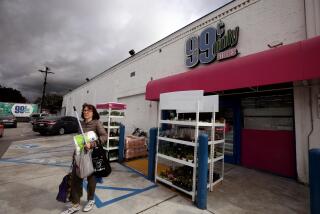Sears, Kmart to close up to 120 stores after holiday sales slump
Sears and Kmart — can you imagine America without them?
With years of weak sales and no turnaround in sight, retail analysts believe that day may be coming.
Sears Holding Co., which controls both chains, laid out plans Tuesday to close as many as 120 outlets after reporting yet another holiday sales slump. Industry observers say the company, which has posted four years of sales declines at its nearly 2,200 full-line U.S. stores, may be joining some other fallen giants in the retailing graveyard.
“It’s on a slow death watch,” said Brian Sozzi, a retail analyst at an independent research firm in New York. “It gives investors a flashback to Circuit City and Borders, which tried to stave off financial troubles by closing stores, but then went out of business completely.”
Wall Street gave its vote Tuesday, sending Sears’ shares down $12.47, or 27%, to $33.38 on speculation that the struggling retailer may be forced into bankruptcy. Less than a year ago, the stock traded at nearly $95.
The Illinois company’s largely middle-class customer base has been sideswiped by a struggling economy, and that has translated into 18 straight quarters of sales declines.
Sears now plans to retool its strategy by channeling resources to the stronger-performing stores after domestic sales dropped 5.2% in the eight weeks leading up to Christmas Day.
Sears Chief Executive Lou D’Ambrosio told employees in an internal memo that the retailer had not “generated the results we were seeking during the holiday.” He said the company probably would come under sharp criticism for the lackluster performance, but pledged that it would “bounce back and become stronger than ever.”
That might be easier said than done. The company said the disappointing holiday performance combined with rising costs will slash fourth-quarter earnings to less than half the $933 million it reported a year earlier.
Bigger rivals like Wal-Mart Stores Inc. and Target Corp. have been steadily luring bargain-hunting shoppers with upgraded stores and trendier merchandise. Analysts have criticized Sears for letting its brands languish by failing to spruce up locations and under-investing in marketing.
“It’s sad to see Kmart and Sears decline so rapidly, so fast,” said Britt Beemer, founder of consumer behavior firm America’s Research Group. “They are not fixing their problems. The Sears apparel strategy is still not what the Sears customer wants. They have not spent money to refurbish their stores to make them modern and contemporary for the under-35 shopper.”
Billionaire financier Edward Lampert, who made his fortune on Wall Street scooping up distressed companies and rebuilding them, gained control of Kmart in 2003 after buying the ailing retailer out of Chapter 11. Two years later he orchestrated the acquisition of Sears, Roebuck & Co. in an $11.5-billion deal that created the nation’s third-largest retail operation.
As chairman of Sears, Lampert pledged to revitalize the combined company by holding down costs, closely controlling inventories and slashing investment in stores. The plan provided a short-term boost that won him high praise for being a savvy businessman, and even comparisons to billionaire investor Warren Buffett.
But analysts say the cost-cutting strategy alienated Sears and Kmart customers.
“The stores are not fresh and appealing, and the company has not invested in modernizing them and keeping people wanting to come back,” said Ron Friedman, a retail expert at advisory and accounting firm Marcum in Los Angeles. “They remind me of J.C. Penney many, many years ago — they were known for cheap, junky-looking stores before they went in and modernized all the stores.”
The Sears store in Boyle Heights, one of 80 full-line shops in California, seems a throwback to a bygone retail era. The store’s signage has faded paint, and an adjacent warehouse has broken windows on some upper floors.
A sign at the entrance reads “Over 75 years in Boyle Heights and here to stay.”
Inside the store are cracked floor tiles, and a beauty parlor is closed, a row of hair-drying stations abandoned.
Toni Sanchez, a 38-year-old teacher from East L.A., remembers her mother’s first job was as a salesclerk at the landmark store. She said she doesn’t shop there much because the store has become too run-down. She said her husband, a custodian, buys jeans and tools there.
“The building is just so old,” she said.
The current stagnation plaguing Sears is a far cry from its innovative roots, which stretch back 125 years to Richard Sears, who started a watch company in 1886 in Minneapolis and later hooked up with partner Alvah Roebuck.
Together the pair founded Sears, Roebuck & Co., a mail-order catalog company that catered to farmers with goods that were cheaper than what could be found at the local store. At one point, Sears even sold mail-order homes that included all materials and detailed construction manuals.
These days the retailer has been trying to shed its dowdy reputation. In August it launched the Kardashian Kollection, a new clothing and accessories line designed by tabloid staples and reality TV stars Kim, Khloe and Kourtney Kardashian. The marketing blitz featured numerous ads with the sisters dressed in clingy, coordinated leopard-print outfits.
Those efforts have yet to pay off.
“Their gross margins have deteriorated significantly, which is a sign they are still having problems resonating with customers, except to deeply discounted items,” said Philip Emma, managing director of R.W. Pressprich & Co.
Sears is not in the same position as Borders or Circuit City. Unlike those defunct retailers, the company has vast real estate holdings because it owns an estimated 800 of its stores in the U.S. In addition, the company has about $700 million in cash and a $2.9-billion credit line, Sears spokeswoman Kimberly Freely said.
“While our operating performance has not met our expectations, we have significant assets — including between $8 billion and $10 billion in inventory as well as a large portfolio of owned real estate, and market leading proprietary brands (Kenmore, Craftsman and DieHard),” Freely wrote in an email. “Together with our liquidity this provides our company with ample financial flexibility.”
A decision on which stores will be closed has not been made. The list of stores to be closed will be posted at https://www.searsmedia.com.
There is some question about whether Sears can manage to sell or sublease many of the soon-to-be empty spaces, many of which are in undesirable locations.
“Many malls that Sears anchored are zombie malls,” Sozzi said. “They don’t generate the traffic they did 10, 15 years ago due to online competition, or an outlet opening nearby, or a newer, fresher mall opening nearby.”
Unless Sears takes action to spruce up its stores and revamp its merchandise, analysts predict, the company will slide to its demise in coming years.
“I hate to say it, but it might be like someone going into Alzheimer’s — it’s that long goodbye,” Beemer said. “I am fearful we are going to talk about Sears for the next 10 years until they’re gone.”
The Associated Press was used in compiling this report.








